Catching up with Blank Slate: a malspam campaign still going strong
Introduction
"Blank Slate" is the nickname for a malicious spam (malspam) campaign pushing ransomware targeting Windows hosts. I've already discussed this campaign in a previous diary back in March 2017. It has consistently sent out malspam since then. Today I collected 11 Blank Slate emails, so this diary examines recent developments from the Blank Slate campaign.
Today's Blank Slate malspam was pushing Cerber and GlobeImposter ransomware.

Shown above: Screenshot of spreadsheet tracking for the 11 emails (image 1 of 3).

Shown above: Screenshot of spreadsheet tracking for the 11 emails (image 2 of 3).

Shown above: Screenshot of spreadsheet tracking for the 11 emails (image 3 of 3).
The malspam
Normally, emails from this campaign are blank messages with vague subject lines and attachments that don't indicate what it is. That's why I've been calling it the "Blank Slate" campaign.

Shown above: Example of a typical Blank Slate email from today, Wednesday 2017-06-28.
However, since yesterday, the Blank Slate campaign has sent several Microsoft-themed messages. We've seen this before. As recently as 2017-04-13, I documented Blank Slate malspam using fake Microsoft messages that led to fake Chrome installation pages. Those fake Chrome pages sent victims zip archives containing malicious .js files designed to infect Windows hosts with ransomware.
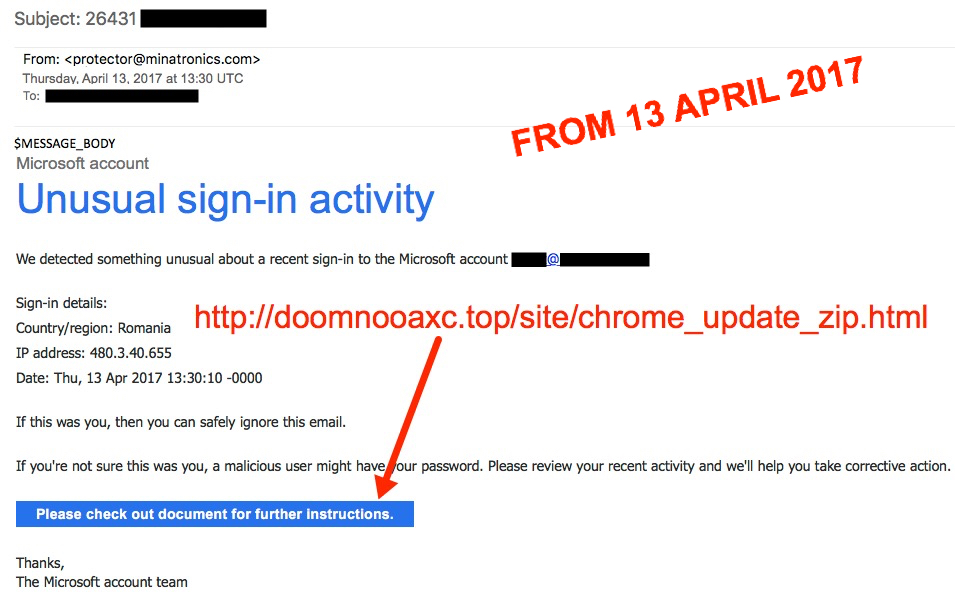
Shown above: Microsoft-themed Blank Slate email from April 2017.
Today's messages look similar to previous Microsoft-themed emails; however, this time they don't have links to a fake Chrome page. Instead, they have zip attachments containing malicious .js files.
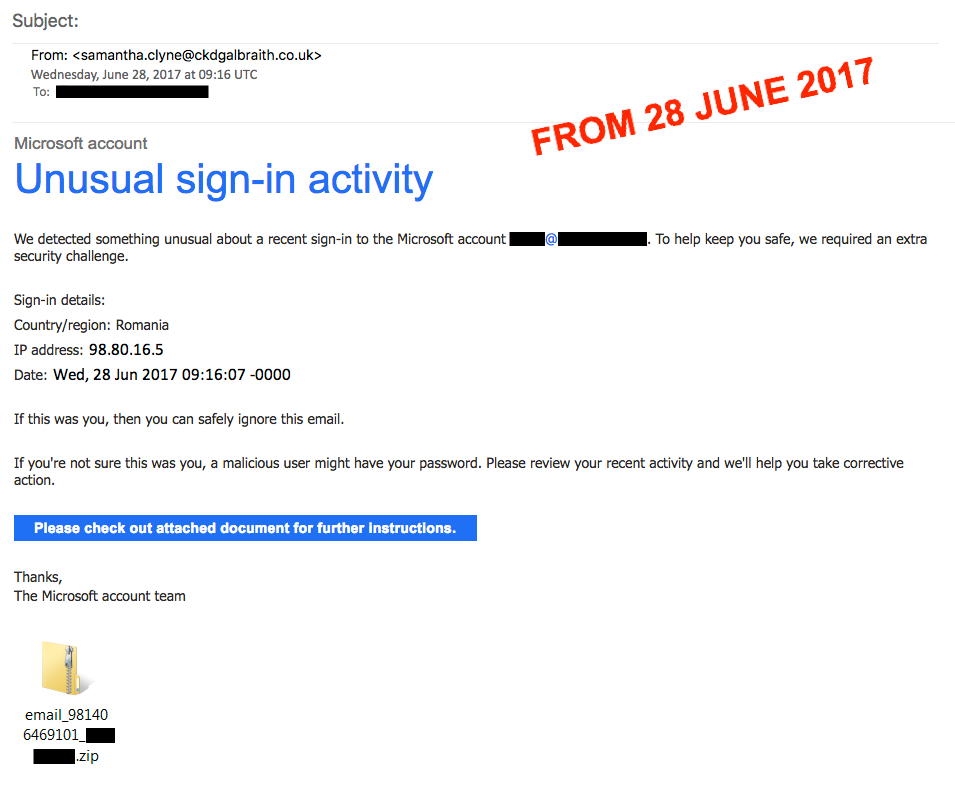
Shown above: Microsoft-themed Blank Slate email from today, Wednesday 2017-06-28.
Otherwise, these emails are similar to previous waves of Blank Slate malspam.
The attachments
As usual, the zip attachments are double-zipped, and they contain a .js file designed to infect a Windows computer with ransomware. I saw two types of .js files. One was about 9 kB in size, and it ran the downloaded ransomware from the user's AppData\Local\Temp directory. The other type of .js file was about 31 kB in size, and it ran the downloaded ransomware from the user's AppData\Roaming\Microsoft\Windows\Templates directory.

Shown above: Example of a 9 kB .js file from this wave of malspam.
The traffic
Traffic is also typical of what we've seen before with Blank Slate malspam. Ransomware binaries are typically downloaded in the clear from a domain name ending with .top.

Shown above: Ransomware binary downloaded by one of the .js files.
No post-infection traffic was noted for today's GlobeImposter ransomware. I saw the typical post-infection for today's Cerber samples.

Shown above: Traffic generated by a Cerber sample from today's malspam, filtered in Wireshark.
Post infection
As others have noted Twitter and elsewhere, recent Cerber samples use "CRBR" as their name in the decryption instructions. File extensions used by Cerber for any encrypted files consist of 4 characters based on the MachineGuid of the infected Windows host.
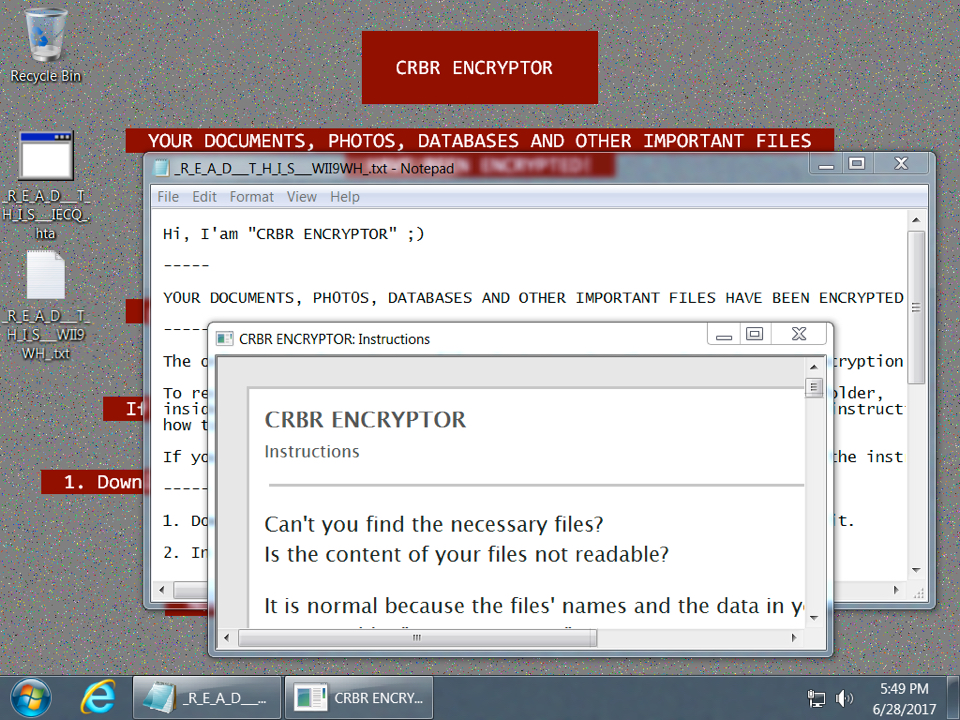
Shown above: Desktop of a Windows host infected with one of today's Cerber samples.

Shown above: Based on the above MachineGuid, and all my encrypted files end with .BRAD
GlobeImposter also acts the same as we've seen before. Encrypted files use the .crypt file extension.
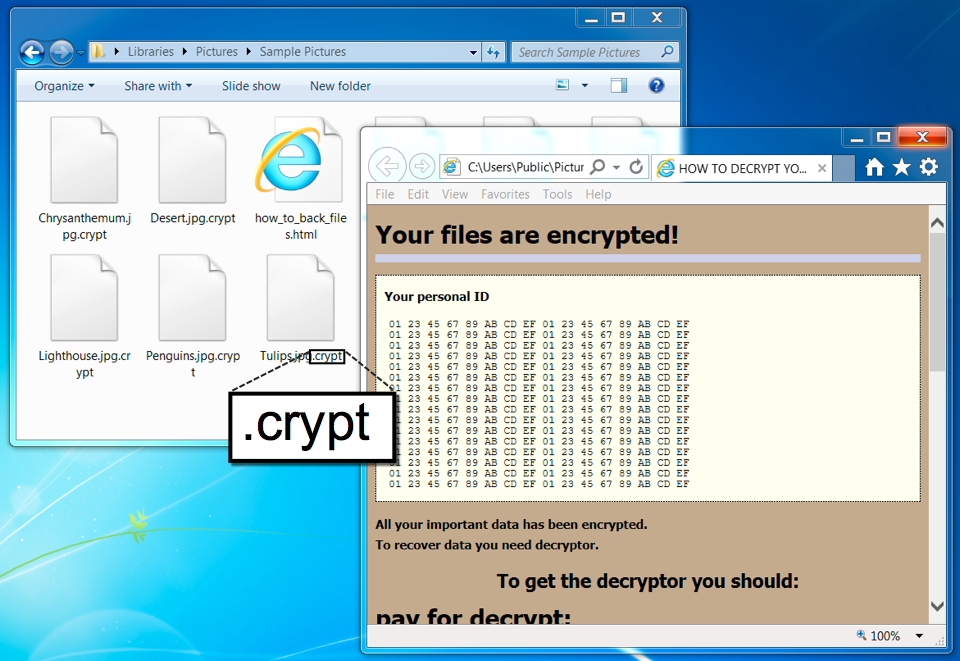
Shown above: Desktop from a Windows host infected with today's GlobeImposter sample.
Indicators of Compromise (IOCs)
The following are SHA256 hashes for the today's extracted .js files:
- 10358fb055b8d8e0d486eafc66be180d52481667fb63bf4e37bf9cafe5a0dbdb - 7941.js
- 153b11ae2df30b671bd0bd54af55f83fd2a69e47c8bb924b842bc1b44be65859 - 25601.js
- 1cbf043831b16ca83eeaff24f70b1a3ea4973d2609e64db33fd82cc0629f1976 - 6935.js
- 567bb9c835306e02dbedc5f10e32c77a2c6f1c2f28ff49c753f963776a9378b5 - 30085.js
- 7ecd1253aad0935df1249d6504d3f4090a00466fa159c2ec4e2d141b4b75068f - 9177.js
- 8b7202a672290e651f9d3c175daaf2b8a3635eba193e925da41bd880a611f2af - 13521.js
- 8ec6455eb9f8a72fef35e9a330e59153f76b8ebd848c340024669e52589ceb18 - 23288.js
- b6ab00337d1e40f894ca3959ee9a19e4c9e59605ed1f2563f0bde4df5f76981b - 27465.js
- c9f71912dd39d4d4ed9f54f6a51f99ee0687e084c2e8782f0b0d729b743e7281 - 3047.js
- d19233fd99213f5a1d299662d9693eb6bc108d72ce676893bc69c8d309caa54a - 26715.js
- ed855d0b4cfd5150a4b44a1d3b6c26224e2990743d977804bab926d569aa963b - 24703.js
The following are SHA256 hashes for ransomware samples downloaded by the extracted .js files:
- 0dc831b502f29d4a6a68da9e511feb8c646af4fcfdeaaee301cb5b0dbaf47c5f - Cerber
- 703b1ea2b0310efdc194b178c777c2e63d5ad1b7f2ac629c01ffa1b36859ba2f - GlobeImposter
- b1be5af4169014508b17d2de5aa581ea62988cc4d3570ed2ed7f9fb931a5902b - Cerber
- d1ed3742380539fbef51804e1335c87dd0ef24a6de7f0aa09ce26ad1efe4bcef - Cerber
The following are domains, HTTP requests, and IP addresses associated with today's Blank Slate malspam:
- 103.52.216.15 port 80 - coolfamerl.top - GET /1 [returned Cerber]
- 103.52.216.15 port 80 - clippodoops.top - GET /403 [returned GlobeImposter]
- 103.52.216.15 port 80 - clippodoops.top - GET /1 [returned Cerber]
- 77.12.57.0 thru 77.12.57.31 (77.12.57.0/27) UDP port 6893 [Cerber post-infection scan]
- 19.48.17.0 thru 19.48.17.31 (77.12.57.0/27) UDP port 6893 [Cerber post-infection scan]
- 87.98.176.0 thru 87.98.179.255 (87.98.176.0/22) UDP port 6893 [Cerber post-infection scan]
- 216.170.123.2 port 80 - xpcx6erilkjced3j.1t2jhk.top - Domain leading to the Cerber decryptor
Email from the GlobeImposter decryption instructions: chines34@protonmail.ch
Final words
As I noted last time, potential victims must open the zip attachment, open the enclosed zip archive, then double-click the final .js file. That works on default Windows configurations, but properly-administered Windows hosts and decent email filtering are enough, I think, to keep most people from worrying about Blank Slate.
This is definitely not as serious the recent Petya/NotPetya ransomware outbreak on 2017-06-27. I still wonder how many people are fooled by Blank Slate malspam. Does anyone know someone who was actually infected from these emails? If so, please share your story in the comments section below.
Pcap and malware samples for this ISC diary can be found here.
---
Brad Duncan
brad [at] malware-traffic-analysis.net
Petya? I hardly know ya! - an ISC update on the 2017-06-27 ransomware outbreak
This is a follow-up the our previous diary on the ransomware outbreak that happened yesterday on Tuesday 2017-06-27.
Introduction
By now, it seems almost everyone has written something about yesterday's ransomware outbreak. This led to some confusion after more information became available, and initial reports were updated. This diary acts as a summary of what we know so far.
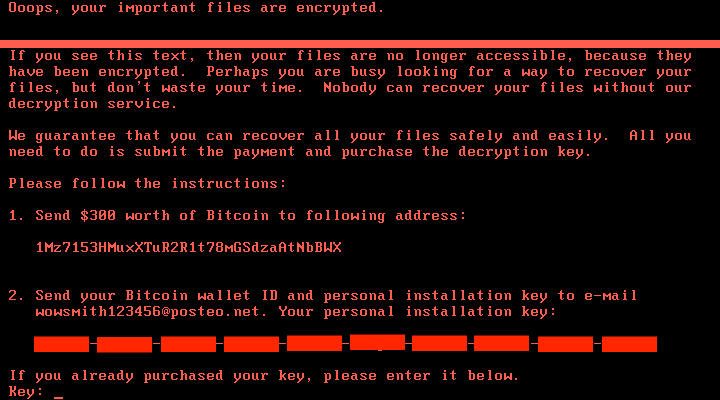
Shown above: Screen shot from a host infected with this ransomware.
What we know so far
This ransomware targets systems running Microsoft Windows. Although initial reporting called this ransomware Petya or a Petya variant, Kaspersky researchers reported it's a new ransomware. Kaspersky has been calling the malware NotPetya, and other names have been floating around for it. However, many people and organizations still call the ransomware Petya or a Petya variant.
This ransomware uses a modified version of the EternalBlue SMB exploit, and it also spreads using other methods like WMI commands, MimiKatz, and PSExec. Although exploits for EternalBlue are relatively recent, malware has been using file shares and WMI to spread for years, and these older techniques don't require any vulnerabilities.
During the infection process, this ransomware overwrites the MBR with a custom boot loader that implements a tiny malicious kernel. That tiny kernel encrypts the master file table (MFT) so the file system is unreadable. The result is an unbootable system that demands a ransom to restore it. The victim is asked to send $300 USD in Bitcoin to a Bitcoin wallet at 1Mz7153HMuxXTuR2R1t78mGSdzaAtNbBWX.

Shown above: Nearly 4 Bitcoin received for that Bitcoin wallet as of 2017-06-28 at 16:44 UTC.
Based on public reports, this attack appears to have originated in Ukraine. According to Krebs on Security the Ukrainian Cyber Police tweeted this attack may have started through a software update mechanism built into M.E.Doc, an accounting program used by companies working with the Ukrainian government. From the Ukraine, it spread to major European firms like Maersk.
Although we've seen some information on files related to this ransomware, we can only confirm two DLL files as samples of the actual ransomware. The SHA256 file hashes are:
- 027cc450ef5f8c5f653329641ec1fed91f694e0d229928963b30f6b0d7d3a745
- 64b0b58a2c030c77fdb2b537b2fcc4af432bc55ffb36599a31d418c7c69e94b1
How can you protect yourself against this threat? Steps include:
- Deploy the latest Microsoft patches, especially MS17-010.
- Consider disabling SMBv1.
- Restrict who has local administrative access. Most people can operate with Standard User accounts instead of Administrator accounts.
- If you have a large or complex infrastructure, segment your network.
- Keep your anti-virus software up-to-date. Vendors are constantly updating definitions to cover the latest malware samples.
Most importantly, you should implement a solid backup and recovery procedure for your critical data, just in case the worst happens and you get infected.
Final words
The day after this ransomware attack, our initial excitement has died down a bit. Affected organizations are conducting response actions, and many others are implementing (or confirming) proper countermeasures.
We hope your organization is following best security practices and is protected against this latest threat.
---
Brad Duncan
brad [at] malware-traffic-analysis.net


Comments